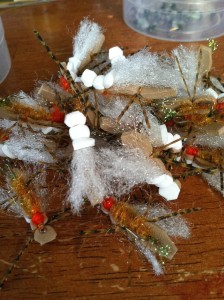For the snowbound angler, winter means bugs flying out of the vise. Nothing motivates a little tying than a quick look at fly boxes that haven’t been opened since that last hatch. Glaring holes are a good place to start. But if you’re a guide, or plan on giving lots of flies to lots of friends, or perhaps you leave too many in the bushes behind you- you better get to filling slots and then some. Lets talk about some tying tips for making the most of your time at the vise.
Size 14 Flash Emergers, ready for dunking.
Crank ’em out, don’t burn out.
For my guide flies I tie two dozen of a pattern before switching to another. I’ll most likely need many more of my go-to patterns, but I’d rather come back and tie a pattern fresh than crank them out by the bin full. For example, the flash emerger in the photo above is a great trailer fly that has taken lots of choosy fish on the Blackfoot, and one that with just a change in dubbing color can take fish any season. Of course I’ll need more for clients, but by keeping it down to the two dozen pictured I can keep the flies consistent and clean.
Production on small stuff means switching patterns every so often, otherwise you’re gonna end up like one of those sweatshop kids with carpal tunnel and cross eyes.
Get a game plan.
Consider your own boxes. Any patterns that worked great last year? Any that never worked? I think you know what ones I’d be tying more of. Every angler that has ever stood on a stream bank in awe of a Blackfoot river evening caddis hatch knows that a simple caddis pattern in the right size is sometimes the only fly you need. Fill your boxes with the flies that work, and leave the experimental tying for the fishing season itself. I find that my best experiments, the ones that have turned into permanent fixtures in my fly boxes, are the ones that came at me in a rush from a great day on the river, or from the frustration of a bad fly on a good day. Until then, I’ve got space in my boxes only for winners. Winning flies get eats. I want eats.
Size 14 Elk Hair Caddis. Quick, easy, and ready to eat.
Take it down a peg.
Can a pattern be simplified? Can a more durable material be substituted? A better one? Can something be left out of the pattern for simplicities sake? Think about the patterns that did work. What feature do you think made them work? Big legs, flashy tails, maybe a synthetic wing that sits just right- all of these are good places to start when tying next year’s flies. What part of the pattern can be simplified? Which one could use improvement? When you go into your tying with a specific idea in mind, good things can happen. Simplifying flies into ones that you can bust out a lot of that still catch fish, is what makes a good fly great.
Size 10 Golden Chubby variation. Foam edible indicators delicious on their own.
Don’t skimp on the double duty flies.
Flies like the chubby chernobyl, the stimulator, and the pink pookie are all go-tos for successful hopper-dropper style combinations throughout the season. Fact is, big overdressed flies and foam make great edible indicators. And for their indicator prowess alone they are worth tying up, even if their main function is embedding themselves in trout lips. Which ain’t a bad use either. Flies that can do double duty are worth an extra dozen or so in your boxes, easy.
The Size 16 Parachute Adams gets two treatments here, both of which have proved in dividends their efficacy on tricky trout: tied in UV purple, and UV olive/grey.
Go smaller.
Size 14 parachute adams. Pretty good bet on a lot of water. But if size 14 worked great last year, don’t forget to tie up some a size down as well. Why? Because sometimes the difference between a landed fish and one that refuses your offering is dropping down a size. So be ready by tying them early and often in your go-to size and one below it as well. Your winter tying will go by faster than you think, and casting all these bugs is going to be well worth it. So get to work and get to tying!
Dylan Tucker
Montana Guide #20822
web: tuckerflyfishing.com







